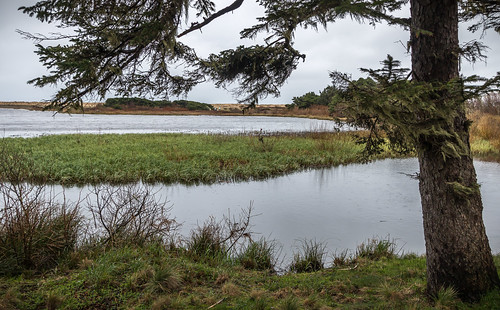Springtime brings key decisions for winter wheat
PENDLETON, Ore. — Morning dew gleamed in the sun Thursday along Duff Road north of Pendleton, where James Harri prepared to scout one of several large wheat fields on his Honda 4-wheeler.
The vehicle is essentially his second office, Harri joked, as he scanned for weeds hidden among rows of young green wheat. It will take him roughly an hour to ride all 314 acres, noting potential trouble spots on a map loaded to his computer tablet.
Winter wheat is finally coming out of dormancy, and the decisions farmers make now will determine the health of the crop leading up to harvest. As a certified crop advisor for the McGregor Company in Adams, it is Harri’s job to be the eyes on the ground and figure out what kind of fertilizer and chemicals are needed for clients to maximize their yield.
High yields are especially important this year, given the global downturn in wheat prices. The crop is currently fetching less than $5 per bushel in Portland.
Diseases like stripe rust and snow mold can easily thwart yields if they are not managed properly, along with invasive weeds that rob moisture and nutrients from the field. That is why springtime is so crucial for growers, Harri said.
“The healthier we can keep these plants earlier in the season, and the cleaner we can keep the field from invasive weeds robbing moisture and nutrients, the better,” Harri said.
Unlike the past few years, drought will not be an issue. Harri said Adams recently experienced its second-wettest February on record, and has received a whopping 15 inches of precipitation since August. Normally, the area clocks in at 16.5 inches for the entire water year.
All that moisture is a blessing for dryland farms, Harri said, but isn’t without its own set of challenges. Stripe rust, for example, thrives in cool, soggy environments, and the fungus can cut into wheat yields by 40-80 percent if left untreated.
Harri said he is expecting heavy rust pressure this year, as well as snow mold, another fungal disease that can flatten wheat stands with sickly patches that resemble spider webs.
“It just feeds on that plant tissue,” he said.
As the name suggests, snow mold develops under extensive snow cover that prevents the plant from getting enough air and sunlight. Harri said he expects farmers will start applying fungicide to treat the problem within a week or two.
For farmers like Don and Tom Lieuallen, they depend on people like Harri to help identify issues early and come up with a quick management plan. By the time they see stripe rust in the field, it is already too late.
“We’re talking a potential train wreck,” said Don Lieuallen, who runs the farm on Duff Road with Tom, his son.
That being said, Lieuallen added he would rather deal with too much moisture than not enough.
Don Wysocki, an extension soil scientist for Oregon State University in Pendleton, said wheat stands were already well established going into fall and most are still looking good.
“The water year is well above what we’ve been seeing,” Wysocki said. “That, to me, is an optimistic outlook.”
Tim Watts, regional commercial manager for Monsanto WestBred, said he has also been busy with wheat stand assessments across the Columbia Basin. His clients range from Pendleton and La Grande to Wasco and Madras.
The snow cover isn’t all bad, Watts said. Snow can act as an insulator against the cold air and shield from debris in high winds. But like Harri, he advises growers to keep a close watch for diseases early this season.
“Anytime we have a heavy winter, those disease issues tend to be a little more prevalent,” Watts said.
In addition, Harri said the plethora of moisture has also flushed many nutrients deeper into the soil — in some cases as much as 4 feet down, where the roots of young wheat plants cannot reach.
Harri recommended the Lieuallens spread additional fertilizer over the topsoil to make up for that deficiency. It may still take a while before things are dry enough to start bringing heavy machinery on to the fields.
“Most growers are just anxious to get done what they need to get done,” he said.


